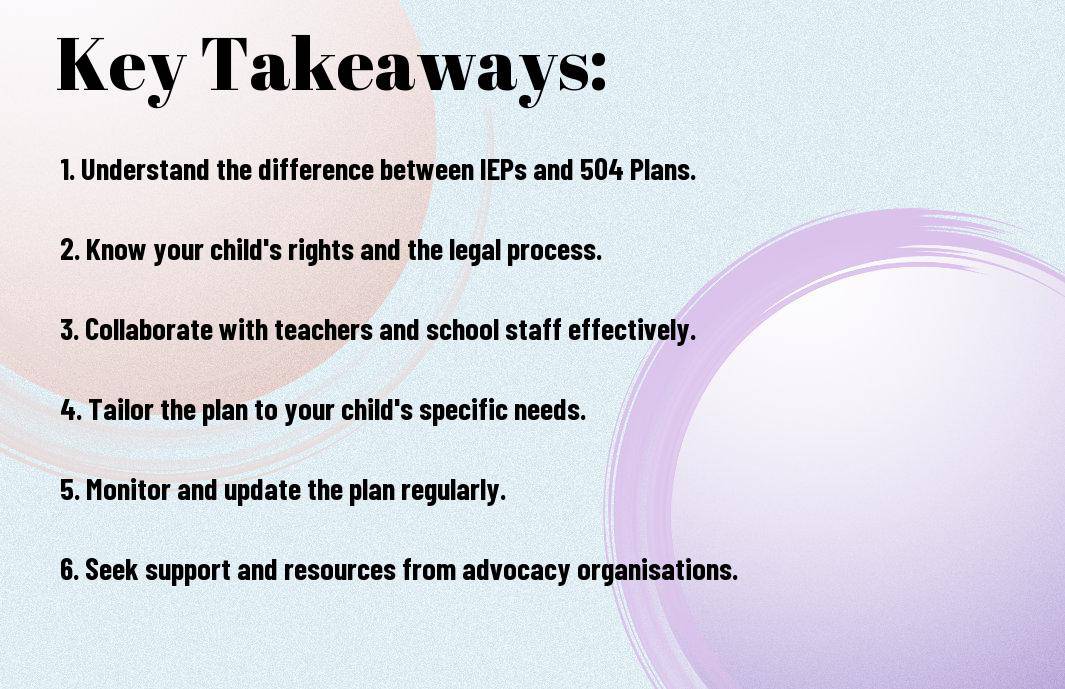Perplexed by the intricacies of Individualized Education Programs (IEPs) and 504 Plans? You’re not alone. These vital documents serve as powerful tools in ensuring that your child receives the support and accommodations they need to thrive academically. Understanding the ins and outs of these plans is essential for any parent navigating the educational system with a child who has special needs. In this blog post, we will delve into the key differences between IEPs and 504 Plans, and explore the importance of advocating for your child’s educational needs. We’ll discuss the potential pitfalls to watch out for, as well as the positive outcomes that can result from effectively advocating for your child. By the end of this post, you’ll have a clearer understanding of how to be a strong advocate for your child’s educational rights.
Key Takeaways:
- Understanding the differences: It is important for parents to fully understand the differences between IEPs and 504 plans in order to advocate effectively for their child’s needs.
- Collaboration with school staff: Building strong communication and partnerships with school staff, including teachers and administrators, is crucial in ensuring that the appropriate support is in place for the child.
- Know your rights: Parents should familiarise themselves with their rights under the law, including the Equality Act 2010, to ensure that their child receives the accommodations and resources they are entitled to.


Deciphering the Differences
Understanding the differences between Individualized Education Plans (IEPs) and 504 Plans is crucial for parents advocating for their child’s educational needs. While both plans aim to provide support and accommodations for students with disabilities, they have distinct purposes and eligibility requirements.
What is an IEP?
An Individualized Education Plan (IEP) is a legally binding document developed for students who qualify for special education services under the Individuals with Disabilities Education Act (IDEA). It outlines the student’s specific learning needs, academic goals, and the services and accommodations they will receive to help them succeed in the classroom. The development of an IEP involves a team of professionals, including parents, teachers, and special education staff, working together to create a tailored educational program for the student.
What is a 504 Plan?
A 504 Plan is named after Section 504 of the Rehabilitation Act and is designed to provide accommodations and support to students with disabilities who do not qualify for special education services under IDEA. This plan ensures that students with disabilities have equal access to education and the opportunity to participate in school programs and activities. It outlines the accommodations and modifications that will be provided to support the student’s learning and remove barriers to their education.
It is important to note that while a 504 Plan does not offer the same level of individualized instruction as an IEP, it still provides essential support to students with disabilities and can make a significant impact on their educational experience.

The Advocacy Process
When advocating for your child’s needs, it’s important to understand the advocacy process and educate yourself about the options available. This includes being knowledgeable about Individualized Education Programs (IEPs) and 504 Plans. To learn more about IEP’s and 504 Plans, you can visit here.
Identifying Your Child’s Needs
Identifying your child’s needs is the first step in advocating for them. This involves gathering information, such as assessments and observations, to understand the specific challenges and strengths of your child. It’s important to highlight key areas where your child may need support and accommodations in the educational setting, such as in the areas of learning, communication, and social interaction.
Once you have a clear understanding of your child’s needs, you can use this information to advocate for appropriate services and supports within the school system. It’s essential to communicate effectively with school staff to ensure that your child’s needs are understood and addressed.
How to Effectively Communicate with School Staff
Effective communication with school staff is crucial in the advocacy process. It’s important to establish open and respectful communication with teachers, administrators, and other professionals involved in your child’s education. This may involve assertively expressing your concerns, asking questions, and seeking clarification on educational plans and services.
By maintaining positive and collaborative communication with school staff, you can build a supportive relationship and work together to ensure that your child’s needs are being met.
Furthermore, it’s important to actively engage in discussions and decision-making processes related to your child’s education, advocating for their rights and best interests.
Navigating Meetings and Building Your Advocacy Team
Navigating meetings with school staff and building your advocacy team are vital components of the advocacy process. Attending meetings, such as IEP or 504 Plan meetings, provides an opportunity to discuss your child’s needs and collaborate on developing appropriate educational plans. It’s important to prepare for these meetings by gathering relevant information and clearly expressing your concerns and goals for your child.
In addition to meetings, building an effective advocacy team can strengthen your ability to advocate for your child’s needs. This may include partnering with other parents, educators, and professionals who can provide support, guidance, and expertise in navigating the special education system.
Legal Rights and Responsibilities
When it comes to advocating for your child’s needs through Individualized Education Plans (IEPs) and 504 Plans, it’s crucial to understand the legal rights and responsibilities that govern these processes. Familiarising yourself with the relevant laws and regulations is essential for ensuring that your child receives the support and accommodations they are entitled to.
Federal Laws Governing IEPs and 504 Plans
Both the Individuals with Disabilities Education Act (IDEA) and Section 504 of the Rehabilitation Act of 1973 are two key federal laws that provide legal protections and support for children with disabilities in the education system. IDEA mandates that children with disabilities have access to a free and appropriate public education, including the development of an IEP tailored to their specific needs. On the other hand, Section 504 ensures that students with disabilities are not discriminated against and have access to accommodations that allow them to participate fully in educational activities.
Knowing Your Child’s Rights and Your Own
As a parent, it’s crucial to familiarise yourself with your child’s rights under these laws and your own rights as their advocate. Understanding the specifics of what your child is entitled to can help you navigate the process of developing and implementing their IEP or 504 Plan. This knowledge empowers you to effectively advocate for your child and ensure that their educational needs are met.
Being well-informed about your child’s rights and your responsibilities as a parent can significantly impact the outcome of their education. Empowering yourself with this knowledge equips you to effectively advocate for your child’s needs and navigate any challenges that may arise during the IEP or 504 Plan process. It’s important to stay abreast of any updates or changes to the relevant laws and regulations, as this ensures that you are advocating from a position of strength and understanding.
Implementing and Monitoring the Plan
Best Practices for Implementation
Once your child’s Individualized Education Plan (IEP) or 504 Plan has been developed, it is crucial to ensure that the agreed upon accommodations and supports are effectively implemented in the educational setting. Consistent communication with your child’s teachers and school administrators is key to successful implementation. Regular check-ins and updates can help to address any issues or concerns that may arise, and ensure that the plan is being followed as intended.
Additionally, clear and specific guidelines for implementing the plan should be provided to all relevant school personnel. This may include teachers, special education staff, and any other individuals who will be involved in supporting your child. It is important to advocate for your child’s needs and make sure that everyone involved understands their role in the implementation process.
Keeping Track of Your Child’s Progress and Adjusting the Plan
Monitoring your child’s progress is an essential part of the IEP or 504 Plan process. Regular assessments and feedback should be conducted to determine whether the accommodations and supports outlined in the plan are effectively meeting your child’s needs. If it becomes evident that adjustments are necessary, it is important to advocate for modifications to the plan in order to best support your child’s educational journey.
Keeping track of your child’s progress also involves maintaining open communication with your child’s teachers and school staff. Regular meetings and updates can provide valuable insight into your child’s academic and social development, and help to ensure that the plan is responsive to their evolving needs.
Conclusion: IEPs and 504 Plans – Advocating for Your Child’s Needs
In conclusion, advocating for your child’s needs through IEPs and 504 Plans is a crucial step in ensuring they receive the support and accommodations they require to succeed in their educational environment. By actively participating in the process, parents and caregivers can effectively communicate their child’s unique needs and work collaboratively with school professionals to develop a plan that best serves their child. It is important to stay informed about the rights and options available, and to assertively advocate for your child’s needs within the educational system. While the process may be challenging, it is ultimately essential for securing the necessary resources and support to enable your child to thrive academically and beyond. By empowering yourself with knowledge and leveraging the support of professionals, you can navigate the complexities of IEPs and 504 Plans to ensure your child’s educational success.
IEPs and 504 Plans – Advocating for Your Child’s Needs
Q: What is an IEP?
A: An Individualized Education Plan (IEP) is a legal document that outlines a child’s educational goals and the services and support they require to meet those goals.
Q: What is a 504 Plan?
A: A 504 Plan is a plan developed to ensure that a child with a disability receives accommodations that will ensure their academic success and access to the learning environment.
Q: How can I advocate for my child’s needs within the school system?
A: You can advocate for your child’s needs by educating yourself about their rights, collaborating with the school team, and being informed about the support and services available to them.
Q: What are some common accommodations provided in IEPs and 504 Plans?
A: Common accommodations may include extra time for tests, modified assignments, access to assistive technology, and specific seating arrangements in the classroom.
Q: What are the key differences between an IEP and a 504 Plan?
A: The key difference is that an IEP is for students who require specialized instruction, while a 504 Plan is for students who require accommodations to access the general education curriculum.
Q: How can I ensure that my child’s IEP or 504 Plan is being implemented effectively?
A: You can ensure effective implementation by maintaining open communication with the school team, reviewing your child’s progress regularly, and seeking support from advocacy organisations if needed.
Q: What can I do if I believe my child’s needs are not being met through their IEP or 504 Plan?
A: If you believe your child’s needs are not being met, you can request a meeting with the school team to discuss your concerns, seek guidance from a special education advocate, or consider filing a complaint with the appropriate education authorities.






